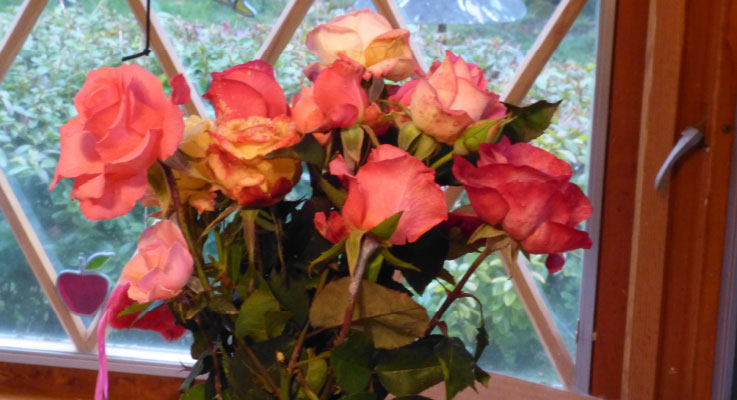Former Portland Rose Society President Rich Baer sent me photo of a bouquet of roses that he took this past Thanksgiving.
The freshly cut blooms were from his yard.
I have lived in the Portland area for many years. It is not often I’ve thought of picking a bouquet of roses at the end of November!
With the mild fall weather, there were many other roses in Rich’s garden with flowers to potentially use in a bouquet. Their blooms had been somewhat soiled due to the recent rains, but the rose plants themselves had not been damaged by any cold weather.
In my own garden in Lake Oswego, I still had some Salvia plants in pots that were blooming in late January. The plants were not as lush as they were in the summer, but they were still flowering and providing a food source for hummingbirds.
The one plant in my garden that astounded me most was a variegated bush bougainvillea. While it didn’t look great, it survived into late January in an area unprotected from the weather.
It’s not unusual
From talking to other gardeners and visiting other gardens this past fall season, what Rich and I experienced is not unusual. Plants are now making it well into the winter that should have died to the ground several months prior. What’s more, some trees and shrubs had swelling buds by mid January. Spring perennials, likewise, were showing new growth buds or perhaps poking through the soil much earlier than usual. This concerns me. I’m always aware of that cold, snowy blast that can appear as late as February around here. We’ve seen it many times.
So, what does this mean for gardeners as we anticipate the up-and-coming spring garden season?
Lori Vollmer from Garden Fever! in Portland said if the weather stays mild, it could be a fantastic year for gardening. With the fall season we just had, where many October days felt like spring, the 2020 garden season could easily be extended once again.
But she cautioned: “One winter of less cold does not mean a permanent change.”
Garden Fever! is not pushing the zone of hardiness, but they do offer plants that may not always be winter hardy. Their sales personnel are taught to let interested customers know these plants carry a winter risk factor.
Meanwhile, low-maintenance, drought-tolerant native plants continue to be in high demand.
Ken Whitten from Portland Nursery echoed Lori’s observations on native plants. The term “native plants” seems to be a trigger in the minds of many customers — something that is perhaps magical. However, I believe that it is important to understand that not all native plants are easily adapted to a home garden. Different native plants require different degrees of sun and shade. The “native” designation does not mean it will survive in any location with no care.
With the Willamette Valley having more heat units, and with warmer and more arid summers, Ken mentioned several other plants that, once rarely seen, are now becoming more common.
Crape myrtles (Lagerstroemia spp.) are readily available at local garden centers and I often see this shrub planted in home gardens. Not only are there new selections to choose from, but new and more vivid flower colors are available with an earlier, longer blooming period.
They thrive in the heat and I have never experienced any insect problems. At one time, powdery mildew was a potential disease issue, but many of the newer selections are resistant.
Ken also mentioned that not too many years ago, it was unusual to see olive trees planted in a home garden setting, or actually, planted anyplace. Now, it’s becoming more common.
The first readily available variety was ‘Arbequina’. It tended to be somewhat more winter hardy than others, and even if damaged, it seemed to bounce back. Newer varieties are now on the market. Olive trees have proven themselves to withstand heat and drought once established.
In my garden, along a very sunny slope, I planted three ‘Arbequina’ olive trees about five years ago. Last summer, with a full and continuous blast of the hot summer sun, they received no supplemental water. They still thrived.
Pointing in the right direction
Although with these extended-season plants, there certain hard goods that are good to have. If this coming summer is hot and dry, it will helpful to apply mulches and compost mixes, particularly when planting something new. These will help hold moisture in the soil.
Soaker hoses and drip irrigation systems are also helpful, as they direct water where needed while reducing waste (and your water bill).
But garden centers can help with more than just supplies. They can provide information to help you succeed in challenging situations where you otherwise could fail. They can pass along knowledge in a personal way the internet cannot match. They can tell you which plants can withstand the full summer sun and which cannot; which plants are going to need supplemental water and which will not.
Don’t forget about shade-loving plants as an option. With many new homes being built close together, one home will often shade another. Shade-loving plants can thrive in such a situation.
Your local garden center has expertise on the local area — what works, what doesn’t, what’s easy to care for, and what’s beautiful. You can find local garden centers, specialty nurseries and suppliers near you, and others located all over Oregon, by going to PlantSomethingOregon.com. Just scroll down to the button that says “Find Garden Centers and Nurseries,” and click on it.
You can also order your very own Retail Nurseries & Garden Centers Road Map at plantsomethingoregon.com/order-the-road-map, and plan your next nursery road trip. There’s a lot out there to discover.
Happy hunting!

